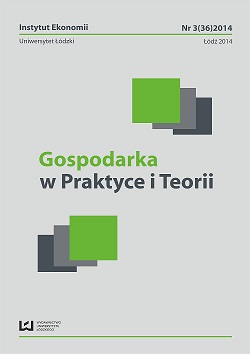The Role of Natural Gas as Energy Source in Poland and Other EU Member States – A Comparative Analysis for the Years 1995–2008
DOI:
https://doi.org/10.18778/1429-3730.36.01Keywords:
natural gas, energy mixAbstract
In the light of the comparative analysis presented in the article it can be stated that in the years 1995–2008 the share of natural gas as an energy source in the EU countries generally increased (with some exceptions). The main contribution was by the electricity sector, but also some industries recorded significant growth in this respect; in the household sector, the second largest gas consumer, the increase was relatively small however. The most important source of growth in demand for natural gas was the substitution in within the fuel mix (replacing coal and fuel oil with gas), as well as an overall increase in energy demand. The limiting factor of the increase in demand for gas has been the growing share of renewables in the energy mix. Poland, compared to EU countries, is characterized by relatively low (though growing) share of gas, especially in the energy sector, which also means a significant potential to increase the scale of the use of this fuel. Examples of individual countries show that under favorable conditions the share of gas in the energy mix can improve significantly even in a relatively short time (several years).
References
Dietzenbacher E., Los B., Structural decomposition techniques: sense and sensitivity, „Economic Systems Research” 1998, no. 10 (4).
Google Scholar
DOI: https://doi.org/10.1080/09535319800000023
European Commission, EU Energy, Transport and GHG Emissions Trends to 2050. Reference Scenario 2013; http://ec.europa.eu/energy/ observatory/trends_2030/doc/trends_ to_2050_update_2013.pdf.
Google Scholar
Genty A., Arto I., Neuwahl F., Final Database of Environmental Satellite Accounts: Technical Report on their Compilation, 2012; http://www.wiod.org/publications/source_docs/ Environmental_Sources.pdf
Google Scholar
International Energy Agency, Are We Entering a Golden Age of Gas, „World Energy Outlook” 2011, Special Report; http://www.worldenergyoutlook.org/media/ weowebsite/2011/WEO2011_GoldenAgeofGasReport.pdf.
Google Scholar
Kaliski M., Krupa M., Sikora A., Potencjał polskiego rynku elektroenergetyki jako możliwy kierunek monetyzacji polskiego gazu łupkowego, Katedra Ekonomiki i Organizacji Przedsiębiorstw Uniwersytetu Ekonomicznego w Krakowie, Kraków 2010.
Google Scholar
Knopf B., Chen Y. H., De Cian E. et al., Beyond 2020 – Strategies and costs for transforming the European energy system, „Climate Change Economics” 2013, no. 4.
Google Scholar
DOI: https://doi.org/10.1142/S2010007813400010
Kronenberg J., Shale Gas Extraction in Poland in the Context of Sustainable Development, „Problems of Sustainable Development” 2014, no. 9 (2).
Google Scholar
Plich M., Determinants of Modelling the Impact of Possible Shale Gas Extraction in Poland, [in:] R. Bardazzi, L. Ghezzi (eds.), Macroeconomic Modelling for Policy Analysis, Firenze University Press, Firenze 2013.
Google Scholar
Plich M., Skrzypek J., Trendy w zużyciu energii w Polsce w latach 1996–2012, Konferencja Środowisko Przyrodnicze a Rozwój, Łódź, 13–15 października 2014.
Google Scholar
Timmer M. P., The World Input-Output Database (WIOD): Contents, Sources and Methods, „WIOD Working Paper” no. 10; http://www.wiod.org/publications/ papers/wiod10.pdf.
Google Scholar
Wood R., Structural decomposition analysis of Australia’s greenhouse gas emissions, „Energy Policy” 2009, no. 37 (11).
Google Scholar
DOI: https://doi.org/10.1016/j.enpol.2009.06.060








